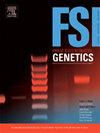甲基化敏感限制性内切酶与重组聚合酶扩增和侧流试纸的偶联检测(月经)血渍
IF 3.1
2区 医学
Q2 GENETICS & HEREDITY
引用次数: 0
摘要
在法医犯罪现场,血液是一种关键且经常遇到的证据。它的检测可以为案件的性质提供有价值的见解,并有助于完善调查重点。血液试纸是最常用的血液检测方法。然而,它很容易产生假阴性结果,特别是在检测犯罪现场发现的微量血液以及具有挑战性的样本时,例如埋在土壤中、用洗涤剂洗涤的样本和老化的样本。在这项研究中,我们开发了一种基于血液特异性甲基化位点(cg04011671)的替代(月经)血检测方法。用甲基化敏感限制性内切酶(MSRE)处理后,用重组聚合酶扩增(RPA)对DNA进行扩增,并通过侧流量尺(LFD)对扩增结果进行可视化。我们的结果表明,MSRE-RPA-LFC方法对体液和物种具有良好的特异性。此外,该方法的灵敏度为125 pg DNA输入,表明其对痕量样品的检测能力高。此外,该方法与后续的DNA分析兼容,与传统的血液试纸(例如FOB试纸)相比,具有优越的检测性能。它可以有效地检测在土壤中埋藏两周或更长时间的样品,用试剂(如过氧化氢或氧漂白剂)清洗过的样品,以及在室温下储存10年、9年和6年的陈化样品。这些发现表明,这种方法可以作为(月经)血鉴定的确认方法,是一种有前途的技术,用于检测痕量和具有挑战性的法医样本(月经)血。本文章由计算机程序翻译,如有差异,请以英文原文为准。
The coupling of methylation-sensitive restriction enzyme with recombinant polymerase amplification and lateral flow dipstick for the detection of (menstrual) blood stains
Blood is a critical and frequently encountered type of evidence at forensic crime scenes. Its detection can provide valuable insights into the nature of a case and help refine investigative focus. The blood test strip is the most commonly used method for blood detection. However, it is prone to false-negative results, especially when detecting trace amounts of blood found at crime scenes, as well as challenging samples, such as those buried in soil, washed with detergents, and aged samples. In this study, we developed an alternative (menstrual) blood detection method based on the blood-specific methylation site (cg04011671). After treatment with a Methylation-Sensitive Restriction Enzyme (MSRE), the DNA is then amplified using Recombinant Polymerase Amplification (RPA), and the amplification is visualized through Lateral Flow Dipstick (LFD). Our results demonstrate that the MSRE-RPA-LFC method exhibits good specificity for body fluids and species. Additionally, this method shows a sensitivity of 125 pg DNA input, indicating its high detection capability for trace samples. Furthermore, this method is compatible with subsequent DNA analysis and demonstrates superior detection performance compared to traditional blood test strips (e.g., FOB test strips). It can effectively detect samples buried in soil for two weeks or longer, samples cleaned with reagents (e.g. hydrogen peroxide or oxygen bleach), and aged samples stored at room temperature for 10, 9, and 6 years. These findings indicate that this method serves as a confirmatory approach for (menstrual) blood identification and is a promising technique for detecting (menstrual) blood in trace and challenging forensic samples.
求助全文
通过发布文献求助,成功后即可免费获取论文全文。
去求助
来源期刊
CiteScore
7.50
自引率
32.30%
发文量
132
审稿时长
11.3 weeks
期刊介绍:
Forensic Science International: Genetics is the premier journal in the field of Forensic Genetics. This branch of Forensic Science can be defined as the application of genetics to human and non-human material (in the sense of a science with the purpose of studying inherited characteristics for the analysis of inter- and intra-specific variations in populations) for the resolution of legal conflicts.
The scope of the journal includes:
Forensic applications of human polymorphism.
Testing of paternity and other family relationships, immigration cases, typing of biological stains and tissues from criminal casework, identification of human remains by DNA testing methodologies.
Description of human polymorphisms of forensic interest, with special interest in DNA polymorphisms.
Autosomal DNA polymorphisms, mini- and microsatellites (or short tandem repeats, STRs), single nucleotide polymorphisms (SNPs), X and Y chromosome polymorphisms, mtDNA polymorphisms, and any other type of DNA variation with potential forensic applications.
Non-human DNA polymorphisms for crime scene investigation.
Population genetics of human polymorphisms of forensic interest.
Population data, especially from DNA polymorphisms of interest for the solution of forensic problems.
DNA typing methodologies and strategies.
Biostatistical methods in forensic genetics.
Evaluation of DNA evidence in forensic problems (such as paternity or immigration cases, criminal casework, identification), classical and new statistical approaches.
Standards in forensic genetics.
Recommendations of regulatory bodies concerning methods, markers, interpretation or strategies or proposals for procedural or technical standards.
Quality control.
Quality control and quality assurance strategies, proficiency testing for DNA typing methodologies.
Criminal DNA databases.
Technical, legal and statistical issues.
General ethical and legal issues related to forensic genetics.

 求助内容:
求助内容: 应助结果提醒方式:
应助结果提醒方式:


